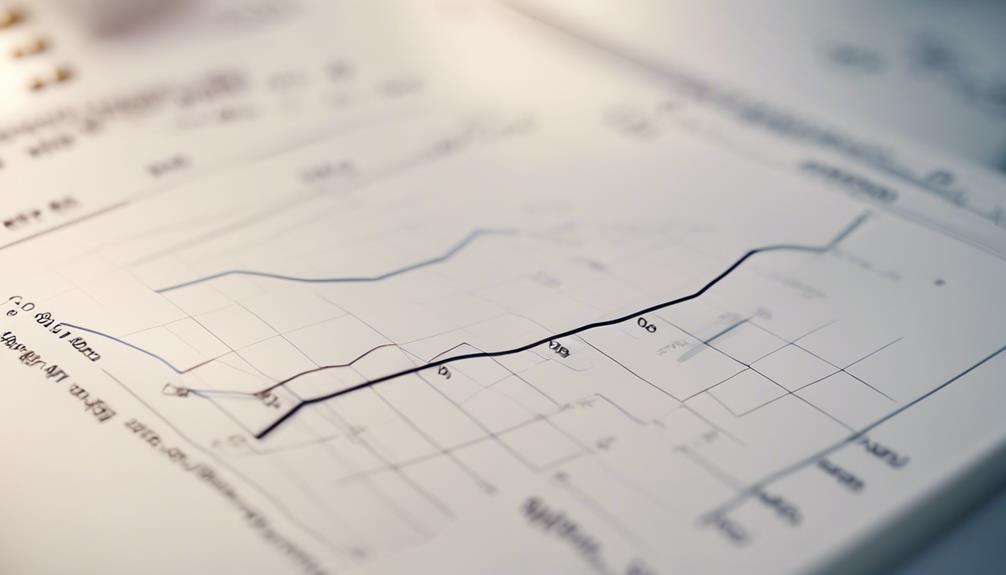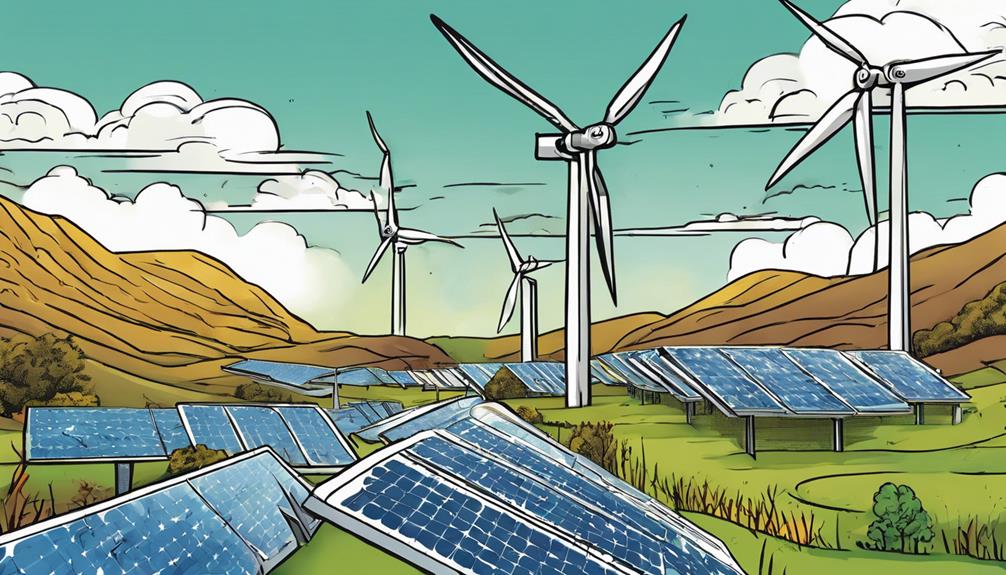To graph energy from a wind turbine, plot power generated at varying wind speeds to showcase the direct relationship between wind velocity and electricity output. This visual representation helps you understand how wind impacts energy production efficiently. By charting these data points, you gain insights into optimizing turbine performance and identifying trends for enhanced efficiency.
Key Takeaways
- Plot wind speed (x-axis) against power output (y-axis) for each data point.
- Use a line graph to connect data points, showing energy output variation with wind speed.
- Include labeled axes with units to indicate wind speed and power output values.
- Create a legend specifying turbine model or data source for clarity.
- Use software like Excel or specialized tools for accurate charting of wind turbine energy production.
Wind Turbine Power Curve Basics
Explore the basics of the wind turbine power curve to understand the relationship between wind speed and power output. The power curve illustrates how a wind turbine's power output varies with different wind speeds. It typically includes key points such as the cut-in speed, rated output power, and cut-out speed for the turbine. This curve is essential for estimating the amount of power a wind turbine can generate at various wind speeds.
By analyzing the power curve, you can assess the performance and efficiency of a wind turbine, helping you make informed decisions about its capabilities. Understanding the power curve is vital for maximizing the energy output of a wind turbine. By graphing the power curve, you can visualize how the turbine's power output changes across different wind speeds. This visual representation allows you to identify the ideal operating range for the turbine and predict its energy production potential under varying wind conditions.
Plotting Wind Turbine Energy Output
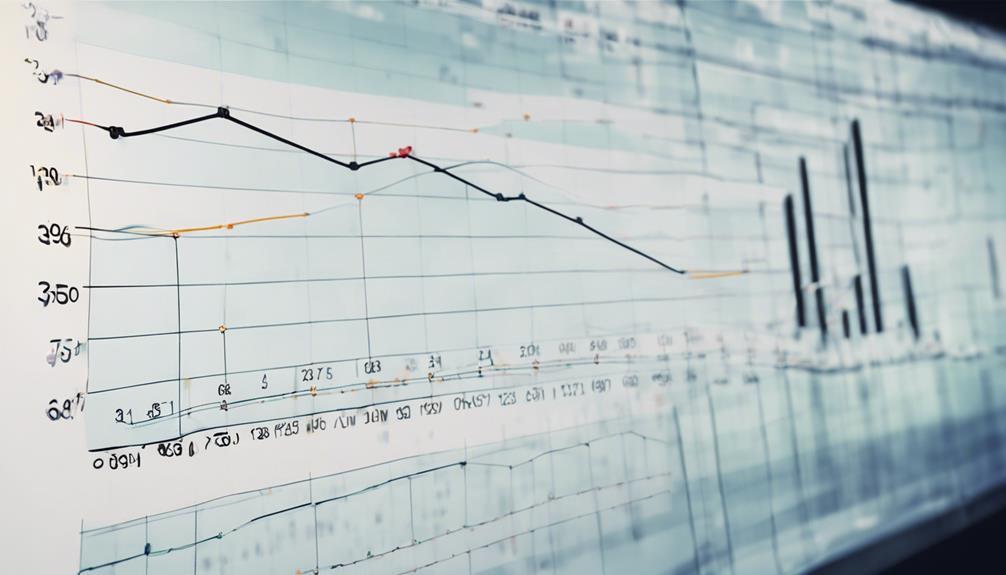
When plotting wind turbine energy output, you'll focus on collecting data points that illustrate the power generated at different wind speeds. These points will help you create a power curve that showcases the relationship between wind speed and energy production.
Wind Energy Variation
Plotting wind turbine energy output provides a visual representation of how energy generation varies with different wind speeds. The fluctuations in wind speed directly impact the amount of electricity produced by the turbine, making it pivotal to understand the relationship between these factors.
By graphing the energy output, you can observe how the turbine's performance changes with varying wind conditions, offering valuable insights into its efficiency and productivity. This visualization helps in estimating the potential electricity generation over time and optimizing the turbine's performance for maximum output.
- Wind energy output is influenced by the average wind speed, affecting the annual output of the turbine.
- The design of wind turbine blades plays a significant role in capturing energy from varying wind speeds efficiently.
- Analyzing the data points on the graph helps in predicting power generation and making informed decisions to enhance overall energy production.
Graphing Turbine Output
To visually analyze wind turbine energy output, graph power output against varying wind speeds. By plotting these data points, you can create a power curve that illustrates how the turbine performs at different wind speeds. This curve is essential for estimating the annual energy production of the turbine and optimizing its efficiency.
When graphing turbine output, the x-axis represents wind speeds, while the y-axis represents power output. The resulting graph allows you to see how the turbine responds to changes in wind conditions, providing valuable insights into its performance.
Below is an example table showcasing hypothetical data for wind speeds and corresponding power output levels:
| Wind Speed (m/s) | Power Output (kW) |
|---|---|
| 5 | 100 |
| 7 | 300 |
| 10 | 600 |
Analyzing turbine output through graphing helps identify the ideal operating range for maximum energy generation and aids in making informed decisions regarding turbine placement and design adjustments.
Understanding Power Curves for Turbines

You'll find that power curves for wind turbines are crucial in understanding how power output changes with varying wind speeds.
These curves are essential for predicting the energy a turbine can generate under different wind conditions.
Knowing the cut-in speed, rated output power, and cut-out speed helps you grasp how turbines function at different wind speeds.
Wind Turbine Power Estimation
Understanding power curves for wind turbines is essential for accurately estimating the energy production based on varying wind speeds. Power curves illustrate the relationship between wind speed and the amount of power a turbine can generate, providing valuable insights into its performance.
To estimate the power output of a wind turbine effectively, consider the following:
- Cut-in Speed: This is the minimum wind speed required for the turbine to start generating power.
- Rated Output Power: The power output the turbine can consistently maintain under ideal wind conditions.
- Cut-out Speed: The maximum wind speed at which the turbine shuts down to prevent damage.
Graphing Energy Output
Graphing energy output from wind turbines reveals how power generation varies with different wind speeds. Power curves, displaying a turbine's energy output at various wind speeds, are important for estimating annual energy production.
Understanding these curves is vital for maximizing turbine performance and maximizing energy generation. By graphing energy output, you can visualize how the turbine's power output changes with fluctuations in wind speed. This visualization helps in evaluating the efficiency of the turbine across different wind conditions.
Power curves provide valuable insights into the relationship between wind speed and energy production, aiding in making informed decisions regarding wind power generation. Analyzing these curves enables operators to identify the most productive operating range for the turbine and adjust settings for best performance.
Calculating Wind Turbine Energy Production
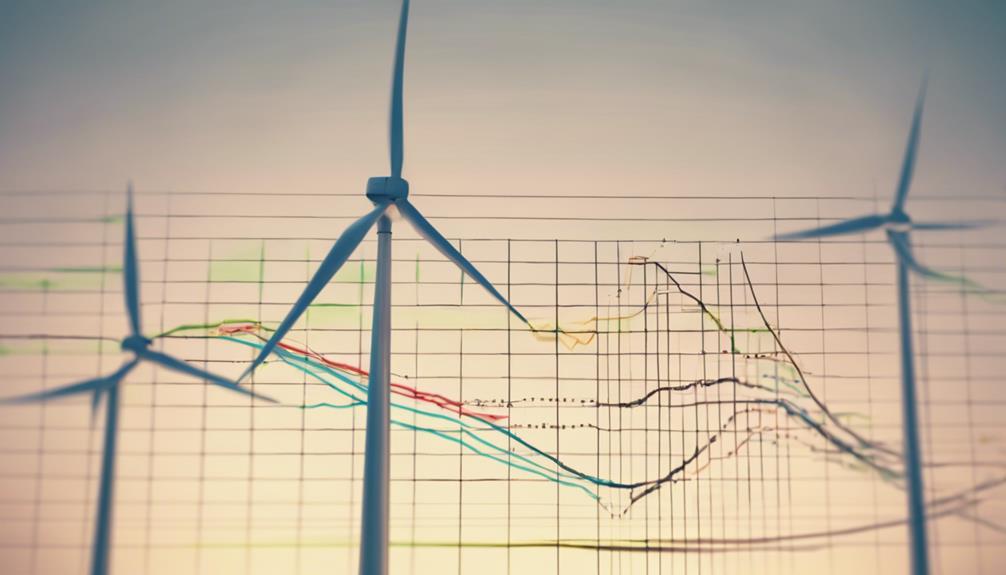
How can you accurately calculate the yearly energy yield of a wind turbine using the formula provided?
To determine the yearly energy generation of a wind turbine, you can utilize the formula 0.0138 x D² x V³, where D represents the diameter of the turbine and V is the wind speed.
Here are some key points to keep in mind when calculating wind turbine energy production:
- Ensure accurate input values for the turbine's diameter and wind speed to obtain precise results.
- Higher wind speeds significantly enhance energy production, highlighting the importance of wind speed in the formula.
- The yearly energy yield can vary significantly with even small increases in wind speed, as illustrated by the example of generating 1,987.2 KWh/pa at 10mph versus 5,452 KWh/pa at 14mph.
Graphing Wind Turbine Power Data
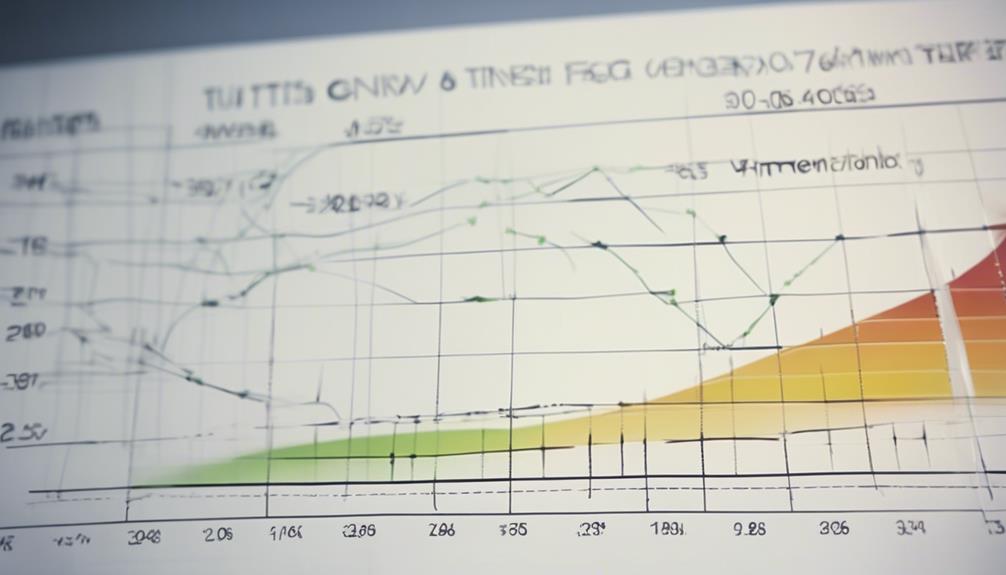
To visually represent the relationship between wind speed and power output of wind turbines, you can graph the power data by plotting wind speed against power output. Each point on the graph corresponds to the power output of the wind turbine at a specific wind speed.
By graphing wind turbine power data, you can easily observe how power output changes with different wind speeds. An upward trend on the graph indicates an increase in power output as wind speed rises. These graphs are essential for analyzing the efficiency and performance of wind turbines under varying wind conditions.
They provide a clear visual representation of how much power a wind turbine can generate at different wind speeds, aiding in decision-making processes regarding turbine placement and optimization strategies. By plotting wind speed against power output, you gain valuable insights into the dynamics of wind turbine energy production.
Interpreting Wind Turbine Power Charts

Understanding wind turbine power charts is crucial for optimizing energy production and efficiency. When interpreting these charts, keep in mind that they show the relationship between wind speed and energy output.
Here are three key points to bear in mind:
- Estimating Energy Production: The curve on the power chart aids in estimating the potential energy production of the wind turbine at different wind speeds.
- Optimizing Turbine Efficiency: By analyzing the data points on the chart, you can determine the efficiency of the turbine and make adjustments to enhance its performance.
- Assessing Productivity: Graphing the energy output from wind turbines allows for a clear assessment of the turbine's productivity and performance over time.
Visualizing Wind Turbine Energy Generation
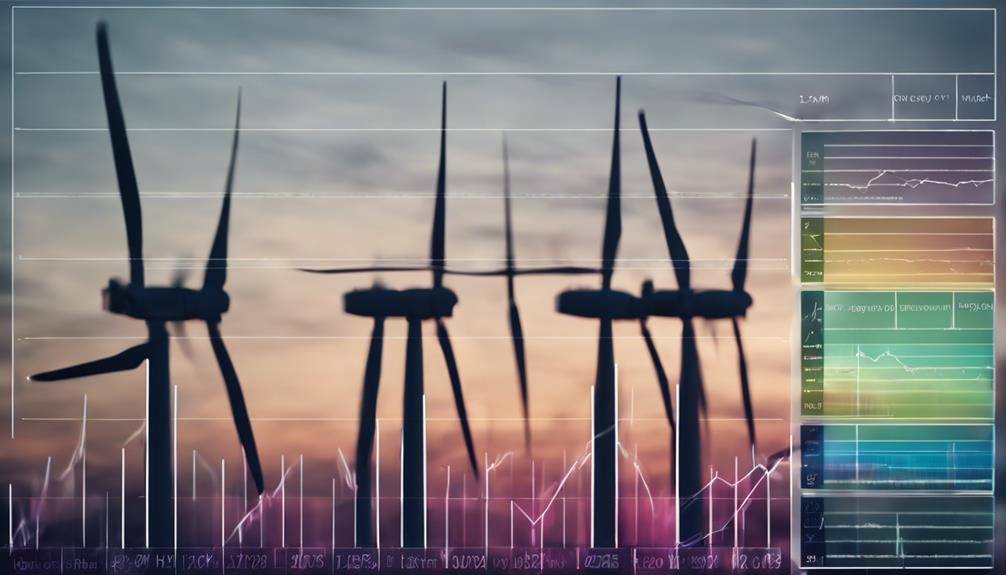
When graphing wind turbine energy generation, plot power output against varying wind speeds to visually represent fluctuations in energy production. This visual representation helps in understanding how renewable energy production changes with the average wind speed. By analyzing the data points on the chart, one can see the direct relationship between wind speed and energy generation. This graph provides valuable insights into the efficiency of a wind turbine under different wind conditions, aiding in optimizing its performance over time.
To further illustrate this concept, consider the following table showcasing hypothetical data points of power output corresponding to different wind speeds:
| Wind Speed (m/s) | Power Output (kW) |
|---|---|
| 5 | 50 |
| 7 | 120 |
| 10 | 200 |
| 12 | 280 |
Frequently Asked Questions
How Do You Calculate Energy Produced by a Wind Turbine?
To calculate energy produced by a wind turbine, you use the formula 0.0138 x D² x V³. Accurate input values are important. Wind speed greatly impacts energy production. Understanding this relationship is key to determining annual energy output.
How Do You Plot a Wind Turbine Power Curve?
To plot a wind turbine power curve, measure wind speed with an anemometer and record turbine power output. Create a graph showing how power changes with wind speed. Use a line of best fit for visualization.
How Do You Get Energy From Wind Turbines?
To get energy from wind turbines, wind turns the blades, generating electricity in the connected generator. The power output fluctuates with wind speed, so understanding the relationship between speed and energy production is key.
How Much Energy Is Produced by Wind Turbines?
You'll understand wind turbine power by relating it to wind speed and rotor size. These factors greatly influence energy output. Visualizing this on a chart clarifies the impact of wind on performance and guides efficiency optimization.
How Can Mechanical Energy from Wind Turbines be Graphed or Visualized?
Understanding mechanical energy explained: Wind turbines extract mechanical energy from the wind to generate electricity. This mechanical energy can be graphed or visualized using data collected from the turbines’ rotational speed, blade angle, and power output. These visualizations help engineers analyze and optimize the efficiency of wind energy production.
Conclusion
To sum up, graphing wind turbine energy output can provide valuable insights into the efficiency and performance of the turbine.
Did you know that the average wind turbine in the United States can generate enough electricity to power over 1,500 homes in a year?
By analyzing power curves and charts, we can better understand how to optimize wind energy production and harness the power of renewable resources for a sustainable future.
